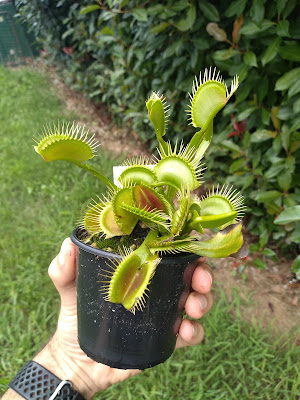A few years ago I started trying to breed a larger variety of dandelion (Taraxacum officionale). I can't quite remember why. It was a lot more difficult that I had imagined, but the results were pretty spectacular. I wrote an earlier blog post on my giant edible dandelions. I do a lot of vegetable breeding, and have produced some spectacular new varieties of plants.
Dandelions are tremendously useful plants. They are edible and far more nutritious than almost every vegetable I can think of. All parts are edible and incredibly nutritious. Livestock and poultry love to eat them, bees and many other beneficial insects adore the flowers. The roots are deep and bring minerals up from the subsoil. A nice coffee substitute can be made from the roots, or the roots can be roasted and eaten as an interesting vegetable. People make coloured dye, syrup, or even wine from the flowers. The flowers are pretty, and kids (and adults like me) like to blow their seed heads.
Here are some leaves of my giant dandelions. While it does change throughout the seasons, leaves over 50cm long are not uncommon. Even the smaller leaves are very large and easily big enough to be useful in a salad.
 |
| Giant edible dandelion |
 |
| Giant edible dandelion leaf |
I find the leaves of regular lawn dandelions to be too small and too bitter to be useful in salads. Leaves of these giant dandelions are far larger than regular dandelions, the pictures above show them on my hand for scale. Being massive they seem to be less bitter. Some people like bitter leaves, but I don't.
I find that bitterness changes in all dandelions. They become more bitter when they flower. They are less bitter when given a lot of water when growing fast. I find new leaves from fast growing plants prior to flowering to be the most tender and least bitter.
 |
| Giant dandelion leaves, 30cm ruler |
 |
| Leaves around 50cm long are not uncommon |
I have grown a number of seedlings from my giant edible dandelion plants and they are spectacularly large.
My giant dandelions seem to need more water than the regular lawn kind, so I figured they would never survive in the lawn as volunteer seedlings. This summer was wet and cool, and a small number of my giant plants have started to grow in my lawn. I am happy with this. I also think next summer they will likely die off. Time will tell on this one.
 |
| Giant edible dandelion leaves |
 |
| Even the small leaves are large enough for salads |
As you can see, leaves of dandelions vary a bit in shape and size on each plant. I really should grow one giant dandelion in a pot and grow a regular dandelion in a pot as a comparison to show just how impressively massive these larger plants are.


























